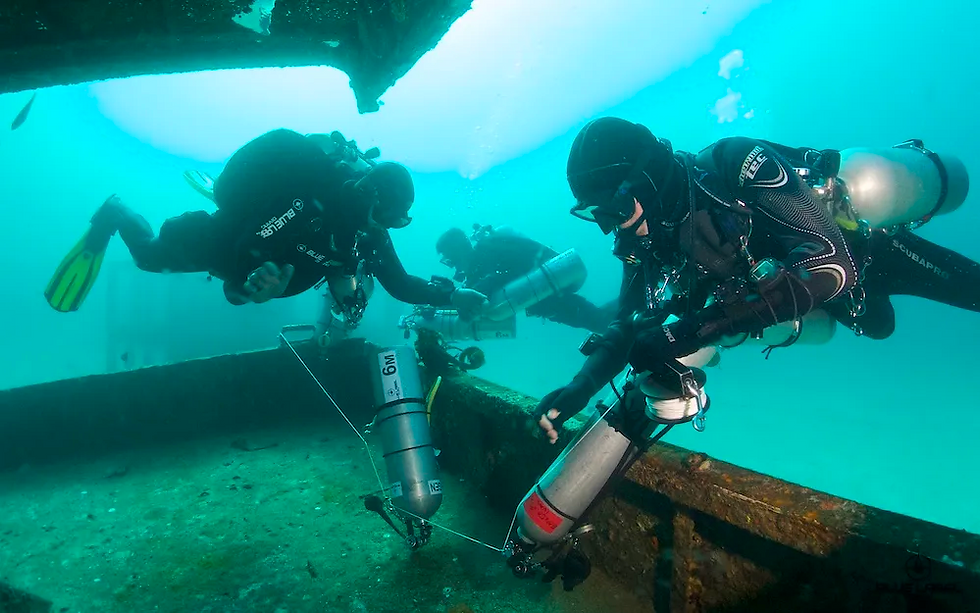What Should I Bring? The Complete Deep Wreck Diving Gear Checklist
- theccrchecklists
- Jan 24
- 4 min read
Deep wreck diving offers an exciting adventure, revealing the hidden treasures and stories beneath the waves. Exploring submerged vessels allows divers to connect with the past in an unforgettable way. However, proper gear is essential for a safe and enjoyable experience. This detailed checklist will equip you with everything needed for your deep wreck diving journey.
Understanding Deep Wreck Diving
Deep wreck diving is an intense experience. It typically involves dives deeper than 30 meters (100 feet), requiring specialized training and equipment to handle risks like nitrogen narcosis and decompression sickness. With the right gear, you can focus on exploring instead of worrying about safety.
Essential Diving Gear
1. Wetsuit or Dry Suit
Choosing the right suit is vital for thermal protection. A wetsuit allows some water in, providing warmth through insulation, suitable for milder temperatures. In contrast, a dry suit keeps you entirely dry, making it essential for colder waters commonly encountered in wreck dives. For example, water temperatures as low as 5°C (41°F) can be found in some wreck sites, where a dry suit offers much-needed comfort. The most recommended drysuit is the SF Tech TNT Pro.

2. Regulator
A dependable regulator is a must for deep diving. Opt for a dual-stage regulator designed for deeper depths. It is wise to have a backup system in place, as studies show that equipment malfunctions account for nearly 25% of diving accidents. The most widely used among technical divers has to be Apeks regulators. Easy serviced world wide by most dive centers.

3. Buoyancy Control Device (BCD)
Your BCD helps manage buoyancy throughout the dive. Make sure it has sufficient lift for the added weights needed for deep diving. A well-fitted BCD not only provides comfort but also stability underwater. Consider a BCD with at least 15 kg (33 lbs) of lift capacity to handle the extra gear effectively. The best and most customizable BCDs out on the market have to be XDeep.

4. Diving Computer
A quality dive computer is essential for planning your dive and managing your time. Look for a model that tracks multiple gases in case you switch gases mid-dive. This capability can be crucial, especially when exploring wrecks beyond 40 meters (130 feet). There are many different computers out there but what sets Shearwater Research apart is there superior customer service and product.

5. Depth Gauge and Compass
Even with a dive computer, a depth gauge and compass serve as reliable backups. A depth gauge helps keep track of how deep you’re diving, while a compass aids in navigating through complex wreck layouts. This is especially helpful in low visibility conditions, which divers may face near wrecks.

Safety Equipment
6. Cutting Device
A strong cutting device is crucial in emergencies. It can cut away entanglements, and its versatility makes it a must-have for unexpected situations. The most common one you will see is the eezycut-trilobite. We recommend having one reachable from each hand.

7. Surface Marker Buoy (SMB)
An SMB is essential for safety during ascents, especially in crowded waters. It alerts surface support to your position and signals your ascent route, avoiding hazards like boats overhead. Having an SMB can improve your safety by over 40%, as it increases your visibility. There are many types but different areas have different protocols for how and when to deploy them. Dive gear express has several options from lift bags to DSMBs.

8. Emergency Surface Signal
Carry an emergency surface signal, such as a whistle or signaling mirror or water dye. These tools improve your ability to communicate your location in case of trouble. The Divesoft Fluorescein Dye marker leaves a substantial discoloration of a huge amount of water in your immediate area which greatly increases your visibility for both the dive boat as well as air support.

9. First Aid Kit
A first aid kit designed for diving is crucial. Ensure it includes items for treating decompression sickness and other diving-related injuries. Having a kit that complies with local regulations can significantly enhance safety. DAN provide premade marine first aid kits ready for any diver.

Lights and Photography Gear
10. Underwater Flashlights
High-quality underwater flashlights are indispensable for exploring dark wrecks. It's recommended to have at least two reliable lights, as 50% of diving incidents occur in low-light conditions. We recommend the OrchaTorch dive lights

11. GoPro or Underwater Camera
Capturing your dive can be exhilarating. A GoPro or another underwater camera helps document your adventure and preserve your memories. Studies show that divers who document their experiences tend to enjoy their dives more thoroughly.
Specialized Gear
12. Additional Weights
Plan for any additional weights you may need for proper buoyancy. Depending on your wetsuit's or dry suit's thickness, extra weight might be vital to reach neutral buoyancy at depth. We recommend using soft weights especially when diving cold water. We recommend using soft weights as they are easier to work with.
Support Gear
13. Dive Bag
A solid dive bag is important to transport your gear safely. Ensure it has compartments to keep everything organized—this reduces the chance of forgetting essential items. OMS makes a stout bag that will hold all your gear and withstand the dive site punishment.
Getting Ready for Your Dive
Preparing for a deep wreck diving adventure involves careful planning and the right equipment. Each item in this checklist contributes to a safe and memorable experience. Remember to check your gear thoroughly before heading out. Always prioritize safety—for yourself, your dive buddy, and the environment. With this checklist handy, dive confidently and explore the hidden wonders beneath the surface.







Comments